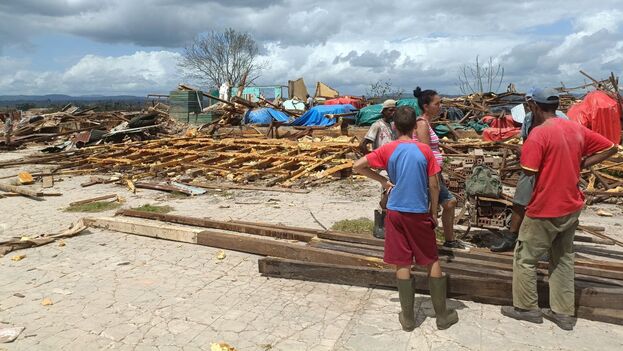
![]() 14ymedio, Havana, 30 September 2022 — The tobacco disaster in the municipality of San Juan y Martínez, in Pinar del Río, leaves alarming figures. As of Wednesday, 151 of Tabacuba’s 155 tobacco storage sheds had totally collapsed. They store the leaf that is grown in the locality, considered the tobacco mecca of the world, and which serves as raw material for the production of cigars.
14ymedio, Havana, 30 September 2022 — The tobacco disaster in the municipality of San Juan y Martínez, in Pinar del Río, leaves alarming figures. As of Wednesday, 151 of Tabacuba’s 155 tobacco storage sheds had totally collapsed. They store the leaf that is grown in the locality, considered the tobacco mecca of the world, and which serves as raw material for the production of cigars.
“As of the 20th of this month, 4,110 tons of tobacco had been collected. Another 157 were in the hands of 67 producers, and the current state of that harvest is not exactly known,” Yosvany López González, the manager of Tabacuba’s analysis department in San Juan y Martínez, told the official press.
The official explained that in the Tabacuba warehouses there was a total of 5,681 tons, including this year’s harvest, the last season’s, in the process of production, and one that is finished. In addition, the Empresa Rama has 152 tons.
Of the 27 warehouses that were reviewed, 15 are completely destroyed, seven have a damaged roof and there are two that have partially collapsed. In addition, the town’s 38 curing houses are on the ground, and, of the 28 curing sheds, half fell completely and the other half partially. There are also five fermentation chambers in San Juan and Martínez to improve the dry tobacco: all of them have a broken roof.
More numbers for the horror: Of the 1,792 curing sheds that belong to producers, 1,739 collapsed, and 8,400 parcels of land have been lost.
“You have to build thatch roofs as soon as possible and transfer the tobacco there,” said the official, who has prioritized the rescue of the product as soon as possible.
The tobacco disaster joins the general state of the province, whose damage was evaluated this Thursday at a meeting, which warned that 100% of the area is without electricity, with the exception of the homes that had generators. The Electric Union of Cuba already has at least 520 workers in Pinar del Río from different areas of the Island to support the reconstruction of the lines.
The linemen of Cienfuegos are working on the repair of two damaged circuits in a well near La Coloma, which is not working like many others due to the lack of electricity. Those who arrived from Sancti Spíritus, on the other hand, continue with the breakdowns of the Abel Santamaría Cuadrado and León Cuervo Rubio hospitals. In addition, other arrivals from Villa Clara work on the connection of Consolación del Sur with the Paso Real substation, in Los Palacios.
At the meeting it was also reported that generators would be used to supply polyclinics, hospitals, well pumps and bakeries, in addition to watertrucks, known as pipas, to distribute water among the population.
The list of damage is endless in the province, which was hit by Hurricane Ian this Tuesday at 3:30 in the morning with winds of more than 125 miles per hour. As of yesterday afternoon, almost 2,953 people were still evacuated, most of them in the homes of family and friends, with the exception of 778 who are in state centers.
Schools and health centers have also suffered their own damage. There are 425 educational facilities affected, of which 396 are schools. The official press says that the provincial Directorate of Education is among the most affected, along with nine municipal directorates, eight municipal warehouses, six “palaces” of pioneers and five camps.
Medical offices and polyclinics in all the municipalities have suffered damage, in addition to other losses in the Third Congress hospital and a nursing home.
Of businesses, 164 have total roof collapses, 136 have partial ones, 18 were completely destroyed, and there were 19 collapses of doors and windows. In addition, the wall of the Corojo swimming pool in San Luis fell down completely, and there is damage to seven funeral homes, two cigar factories, two canteens and three cemeteries.
Communications with Pinar del Río are almost impossible. From the editorial offices of 14ymedio, we have tried to contact, through mobile and fixed telephones, our collaborators in the province without managing to, to date. However, users on social networks warn that the images shown in the official press don’t reflect the extent of the disaster in the area.
Relatives of residents of La Coloma have been asking for more information about the real extent of the tragedy for days and say that there are few videos broadcast by Tele Pinar that really show the rubble and the flooded homes reported by their families.
Translated by Regina Anavy
____________
COLLABORATE WITH OUR WORK: The 14ymedio team is committed to practicing serious journalism that reflects Cuba’s reality in all its depth. Thank you for joining us on this long journey. We invite you to continue supporting us by becoming a member of 14ymedio now. Together we can continue transforming journalism in Cuba.
